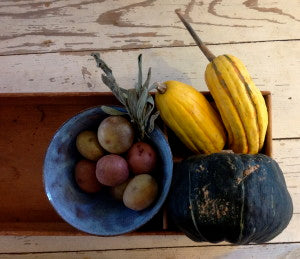 Thanksgiving comes at a time of year ripe for celebration if you’re a gardener. The growing season is completely behind us, the garlic is planted, the beds are cleaned up, and the pantry is full of produce stashed away for the cold months ahead. It’s a good time to spend extra time in the kitchen, enjoying the fruits of your many months of labor.
Thanksgiving comes at a time of year ripe for celebration if you’re a gardener. The growing season is completely behind us, the garlic is planted, the beds are cleaned up, and the pantry is full of produce stashed away for the cold months ahead. It’s a good time to spend extra time in the kitchen, enjoying the fruits of your many months of labor.
Here at the Seed Library, some of us will have a vegetarian Thanksgiving, but all of us will have a Vegetable Thanksgiving because we just can’t help but fill the festive table with highlights of our fall harvest.
This time of year is not only good for grateful conclusions, but also to look to the future – to learning in the darkest, coldest days, planning for the growing season ahead, organizing seeds. In that way, a Vegetable Thanksgiving is a celebration of the start of the winter harvest: the vegetables that are on the table now are the vegetables that will nourish us all the months through to next spring. Here are a few ideas for cooking with winter produce, for a celebratory meal this week and every day till March:
- Winter Squash: the darling of any holiday feast, winter squash is indispensable for pie and soup. Pumpkins are just one (actually, there are many pumpkins) of a myriad varieties of winter squash, which are all a little different in flavor and texture and all of which are great for either sweet or savory dishes.
- Potatoes: the backbone of a hearty meal, potatoes often end up as a base for something tastier, mashed potatoes for gravy, potato-leek soup for leeks and spices… but a fresh potato from the garden is itself delicious. Try it fried or roasted with minimal seasonings, like olive oil, salt, and garlic, to refine your potato-palette.
- Sweet potatoes: make a great pie – like a sweeter, denser version of pumpkin pie. They also make fantastic latkes.
- Onions: often get used as a flavor foundation for other foods, but they can hold their own at the table. Halved and roasted, they are deliciously sweet and pretty on a plate.
- Kale, Collards, and Cabbage: are extremely versatile in their uses, but at a time of year when most of our vegetables are cooked, these brassicas can fulfill cravings for a raw crunch. Try them in a salad, chopped into small pieces, then massages with a little lemon or vinegar until they are softer.
- Fennel: one of the more surprising flavors found in a northern garden, fennel is a welcome surprise when found in stir-fries or mixed in with grains.
- Cauliflower: this special seasonal treat can add a nice, mild flavor to nearly any vegetable dish, but rubbed with spices and oil and roasted whole, it becomes the main event, taking on deep, smoky flavor and an impressive look.
- Carrots and Beets: are roots to save for dessert. For alternatives (or additions!) to Pumpkin pie – A Carrot Cake (with Kaleidoscope Carrots grated on top) is an easy hit… as is Beet Red Velvet Cupcakes or a Beet Chocolate Cake. Using either juicy vegetable in a cake or bread keeps any baked good from drying out.





